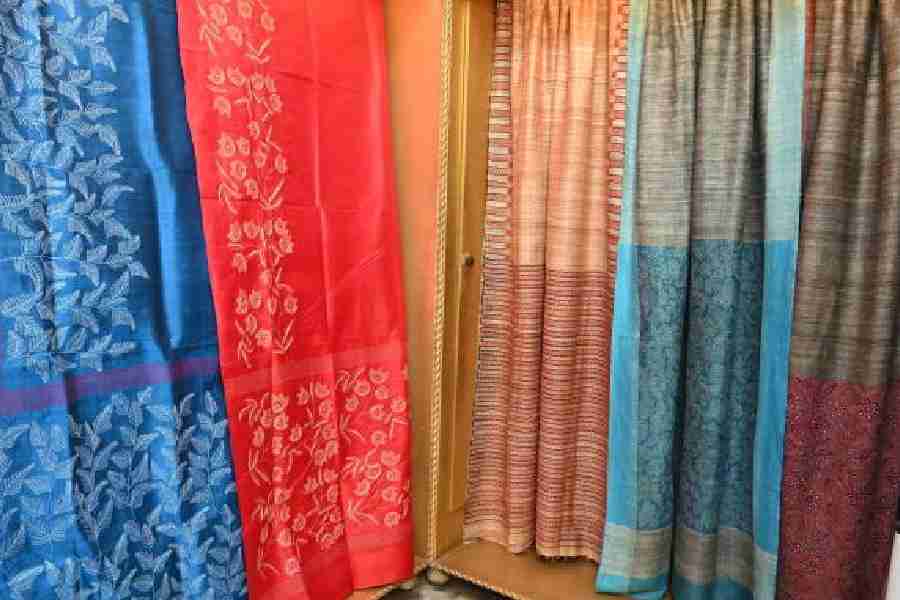The fifth edition of ‘Spinning Yarns’ at Byloom saw Santiniketan-based brand Alcha’s proprietor Keya Sarkar share her entrepreneurial journey of starting out from scratch after leaving her corporate job in Mumbai. Talking about how it all started, she said: “My first introduction to craft happened when we went on family visits to Santiniketan because ma insisted we go to Ananda Mela, Magh Mela, Poush Mela and Nandan Mela. That’s when I saw that everyday objects could be made so beautiful. This stayed with me.... And, then thanks to my job in the financial sector, I managed to roam the world. And that’s when I realised that in between my corporate work, I was figuring out what craft was available where and that what I had seen in Santiniketan was of high quality and of great skill, which was kind of vanishing from across the world. Then after spending 20 years in Bombay, I realised that discussing EMIs and car loans was not really my thing, and I needed to get out of that space. And much to my mother’s horror, I gave up my job at 43 and I came to Santinketan”.
Sarkar “had absolutely no idea” about the road ahead. “When I came to Santinketan, that’s when I realised that all the things that I had seen when I was young, in the 20 years that I had been in Bombay, had completely disappeared. The sense of aesthetics and beauty had completely been overtaken by commercialisation.... The criterion was whether it was affordable. The batik of Karu Sangha or the leather work of Amar Kutir... had all disappeared,” she said. Along with a few friends, Sarkar conceptualised “a space where the middlemen would have no say”. “So we thought we would start a haat where the artisans themselves could have a say in what they were going to do. So 10 of us actually took the initiative of starting what we then called Shonibarer Onnyo Haat,” she added.
And, “a whole new world opened up” for Sarkar, that would pave the way for Alcha. “That was for the first time that I saw people work with terracotta, grass, natural seeds, dokra, bamboo and wood, in addition to the things which I had earlier seen. So, when I started thinking that I could start a place of my own, I knew exactly the things I wanted to do. I first wanted to start with weaving because, to me, the khesh was a fantastic fabric. A cluster in a place called Labpur, a little further away from Santiniketan, was weaving khesh, but when I first saw it, it was only these non-standard single bedcovers in mustard yellow which is considered the Visva Bharati colour. Now the mustard yellow was okay in our Santiniketan house, but I could not really see it in any other urban space in such huge quantities. I had absolutely no credentials. I was not from Kala Bhavan. I was from Bombay. Did I know anything about weaving? No, nothing. So I sort of kept telling them that we could do this and we could we do that and then we started doing yardage. I started using it for cushion covers. It was really a fantastic fabric,” she said.
Soon, she would commission khesh saris. “I asked one weaver whether we could try a sari and he said ‘it has to be a twisted yarn because the warp has to be thick enough to be able to hold this weft.’ I said let’s try. We produced the first few pieces of khesh saris and I gifted one to my cousin who was then teaching at St. Xavier’s College. So she wore it; it was white, and the colour was in many shades of khesh. She told me: ‘I was teaching and I thought somebody kept pulling at my pallu’. Then I realised the pallu was very heavy and the main body light. That’s when we introduced the space in the pallu and inside we put stripes of khesh,” she smiled.
Alcha has also worked with kantha. “The one thing I learnt from the haat is that every single person was copying from the next person. There were no new kantha designs that were coming up which to me was very strange because here was Kala Bhavan and here were the artisans and they never spoke to each other. So, I got people from Kala Bhavan to actually design for me, and that’s actually been the base of our business. I realised that the new designs are the capital of this business,” said Sarkar.
The talk also focused on Sarkar’s work with batik and hand-block prints, the challenges she faced and her learnings.
Alcha’s showcase is on till July 24, at Byloom (58B Hindusthan Park).
Malavika Banerjee, partner, Byloom, said:” The whole idea of this series is to create a platform for practitioners of handloom and handicraft where they share with us their journey”.

